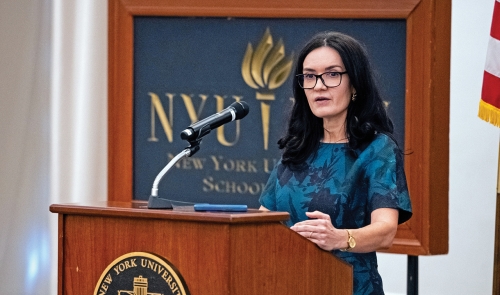In Tillinghast Lecture, Ruth Mason considers $14 billion tax question

Varying interpretations of tax law can have multibillion-dollar implications, as Ruth Mason demonstrated when delivering the 27th annual David R. Tillinghast Lecture on International Taxation on September 10.
Mason, Edwin S. Cohen Distinguished Professor of Law and Taxation at the University of Virginia School of Law and former deputy director of NYU Law’s International Tax Program, began her lecture with a big question: “When is a tax rule simply an ordinary part of a country’s fiscal policy, and when is it an illegal subsidy that distorts competition and violates the law?”
The answer, Mason said, matters to governments formulating national tax policy, to companies making investment decisions, and to citizens concerned about tax burdens and healthy markets.
Mason focused on the state aid rules laid out in the Treaty on the Functioning of the European Union, which prohibits EU member states from offering selective advantages—through cash or taxation—that distort competition. The most prominent case in this vein involves Apple, which in 2016 was ordered to pay the Irish government $14 billion in unpaid Irish taxes, following an investigation by the European Commission.
Apple’s tax plan was “complex,” said Mason, relying on the differing definitions of corporate tax residence codified in US and Irish law, respectively. While the United States defines a corporation’s residence according to where it was incorporated, Ireland considers the location of its management and control. “Apple was able to incorporate companies in Ireland, managing control of them in the United States, and they would be stateless for tax purposes, taxed on their worldwide income by no one,” she explained. “Apple loaded these stateless subsidiaries up with profits in the hopes that they wouldn’t be taxed presently anywhere.”
Ireland appealed the ruling, claiming that the commission was infringing on Ireland’s national sovereignty regarding its tax policy. Apple appealed as well, and the European Court struck down the EU’s action in 2020. But last year the European Court of Justice reversed the 2020 decision, once again leaving Apple on the hook for $14 billion.
According to Mason, however, the Apple case and others that involve EU member states and state aid rules reveal “a pattern of enforcement that’s exposed deep flaws in how we identify subsidies in the tax context.” One problem, said Mason, was that the EU has not clearly defined what state aid is—“particularly when it comes to state aid delivered as tax savings.” And while the European Commission has articulated that one element of illegal state aid is selective advantage, that term is not explicitly defined, either.
“Not even experts can state with confidence what [tax state aid enforcement is] supposed to accomplish,” said Mason. “This is a serious problem that has hampered states’ ability to defend their tax policy choices. They don’t know what they’re defending against because they don’t know what exactly the state aid prohibition is meant to prevent.”
Mason also called into question the EU’s use of tax expenditure analysis—comparing a state’s typical tax law application against a deviation from the reference base to see if it benefits a select group unjustifiably. With varying national tax policies, Mason added, what’s the proper way to determine baselines and deviations from them?
Clouding the Apple litigation picture further, Mason continued, the EU retroactively applied Organisation for Economic Co-operation and Development guidance that did not yet exist in the time period covered by the case and that had not been adopted by Ireland. “The commission used a reference base that was external to Irish law…. Where does the commission get the authority to impose such a norm?” she asked. “If the commission gets to impose an external benchmark in every tax state aid case, then the commission essentially has the power to determine member state tax laws.”
Mason described other cases illustrating problems and inconsistencies in both European Commission actions and EU court rulings in this area. Such examples, she suggested, show the limitations of the approaches adopted by the commission and the courts. “It’s not necessarily that the commission and EU courts have run amok,” she said. “It’s that the cases have involved challenges to structural rules, things like allocation and rates, and the traditional tax expenditure method doesn’t work in those cases.”
Mason’s prescriptions included recognizing the limitations of tax expenditure analysis, as an approach that doesn’t always make sense; issuing guidance on how to determine when it is applicable; and developing new methods to identify illegal state aid.
“These challenges are difficult,” said Mason. “But they’re important to achieving the norms underlying the prohibition of state aid, which at a minimum are that states should not use their tax systems to discriminate between domestic and interstate commerce.”
Watch the video of the event:



